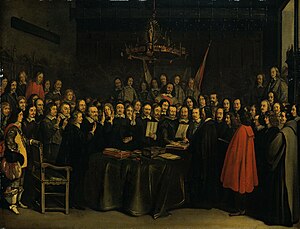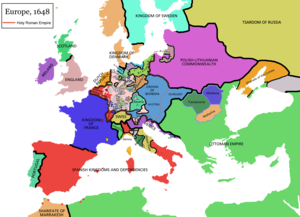Peace of Westphalia
From Wikipedia, the free encyclopedia
The term Peace of Westphalia refers to the two peace treaties of Osnabrück and Münster, signed on May 15 and October 24, 1648, respectively, and written in Latin, that ended both the Thirty Years' War in the Holy Roman Empire (today mostly Germany) and the Eighty Years' War between Spain and the Republic of the Seven United Netherlands. The treaties involved the Holy Roman Emperor, Ferdinand III (Habsburg), the Kingdoms of Spain, France and Sweden, the Netherlands and their respective allies among the princes and the Republican Imperial States of the Holy Roman Empire.
The Peace of Westphalia resulted from the first modern diplomatic congress and initiated a new order in central Europe based on the concept of state sovereignty. Until 1806, the regulations became part of the constitutional laws of the Holy Roman Empire. The Treaty of the Pyrenees, signed in 1659, ended the war between France and Spain and is often considered part of the overall accord.
Contents |
[edit] Locations
Peace negotiations between France and the Habsburgs, provided by the Holy Roman Emperor and the Spanish King, were to be started in Cologne in 1636. These negotiations were blocked by France.
Richelieu of France desired the inclusion of all its allies, whether sovereign or a state within the Holy Roman Empire. In Hamburg and Lübeck, Sweden and the Holy Roman Empire negotiated a treaty - the Treaty of Hamburg. This was done with the intervention of Richelieu.
The Holy Roman Empire and Sweden declared the preparations of Cologne and the Treaty of Hamburg to be preliminaries of an overall peace agreement. This larger agreement was to be negotiated in Westphalia, in the neighboring cities of Münster and Osnabrück. Both cities were to be maintained as neutral and demilitarized zones for the negotiations. Münster was, since its re-Catholization in 1535, a strictly mono-denominational community. It housed the Chapter of the Prince-Bishopric of Münster. Only Roman Catholic worship was permitted. No places of worship were provided for Calvinists and Lutherans.
Osnabrück was a bidenominational Lutheran and Catholic city, with two Lutheran and two Catholic churches for its mostly Lutheran burghers and exclusively Lutheran city council and the Catholic Chapter of the Prince-Bishopric of Osnabrück with pertaining other clergy and also other Catholic inhabitants. In the years of 1628-1633 Osnabrück had been subjected by troops of the Catholic League and the Catholic Prince-Bishop Franz Wilhelm, Count of Wartenberg, imposed the Counter-Reformation onto the city with many Lutheran burgher families being exiled. While under following Swedish occupation Osnabrücks's Catholics were not expelled, but the city severely suffered from Swedish war contributions. Therefore Osnabrück hoped for a great relief becoming neutralised and demilitarised.
Both cities strove for more autonomy, at best for becoming Free Imperial Cities, so they welcomed the peace negotiations, their neutrality and the prohibition of all political influence by parties of the War, including their overlords, the respective prince-bishops, as they were.
While Lutheran Sweden preferred Osnabrück as place of conference, its peace negotiations with the Empire, including the respective allies of both, took place in Osnabrück, the Empire and its opponent France, including again their respective allies, and the Republic of the Seven United Netherlands and its opponent Spain (and their respective allies) negotiated in Münster.[1]
[edit] Delegations
The peace negotiations had no exact beginning and ending, because the participating total of 109 delegations never met in a plenary session, but dropped in between 1643 and 1646 and left between 1647 and 1649. Between January 1646 and July 1647 probably the largest number of diplomats were present. Delegations had been sent by 16 European states, sixty-six Imperial States, representing the interests of a total of 140 involved Imperial States, and 27 interest groups, representing the interests of a variety of a total of 38 groups.[2]
The French delegation was headed by Henri II d'Orléans, duc de Longueville and further comprised the diplomats Claude d'Avaux and Abel Servien. The Swedes plenipotentiaries sent Johan Oxenstierna, the son of chancellor Axel Oxenstierna, and Johann Adler Salvius. The head of the delegation of the Holy Roman Empire for both cities was Count Maximilian von Trautmansdorff; in Münster, his aides were Johann Ludwig von Nassau-Hadamar and Isaak Volmar (a lawyer); in Osnabrück, his team comprised Johann Maximilian von Lamberg and Reichshofrat Johann Krane, a lawyer. The Spanish delegation was headed by Gaspar de Bracamonte y Guzmán. The nuntius of Cologne, Fabio Chigi, and the Venetian envoy Alvise Contarini acted as mediators. Various Imperial States of the Holy Roman Empire also sent delegations. Brandenburg sent several representatives, including Vollmar and Joachim Friedrich von Blumenthal. The Republic of the Seven United Netherlands sent a delegation of eight, and Johann Rudolf Wettstein, the mayor of Basel, represented the Old Swiss Confederacy.
[edit] Results
[edit] Internal political boundaries
The power taken by Ferdinand III in contravention of the Holy Roman Empire's constitution was stripped and returned to the rulers of the Imperial States. This rectification allowed the rulers of the Imperial States to independently decide their religious worship. Protestants and Catholics were redefined as equal before the law, and Calvinism was given legal recognition. [3] [4]
[edit] Tenets
The main tenets of the Peace of Westphalia were:
- All parties would recognize the Peace of Augsburg of 1555, in which each prince would have the right to determine the religion of his own state, the options being Catholicism, Lutheranism, and now Calvinism (the principle of cuius regio, eius religio). [3] [4]
- Christians living in principalities where their denomination was not the established church were guaranteed the right to practice their faith in public during allotted hours and in private at their will. [3]
There were also territorial adjustments:
- The independence of the Netherlands, Switzerland, Savoy, Milan, Genoa, Mantua, Tuscany, Lucca, Modena and Parma from the Empire was formally recognized; many of these territories had enjoyed de facto independence for decades.
- The majority of the Peace's terms can be attributed to the work of Cardinal Mazarin, the de facto leader of France at the time (the king, Louis XIV, being a child). Not surprisingly, France came out of the war in a far better position than any of the other participants. France won control of the Bishoprics of Metz, Toul and Verdun near Lorraine, and the cities of the Décapole in Alsace (but not Strasbourg, the Bishopric of Strasbourg, or Mülhausen).
- Sweden received an indemnity, as well as control of Western Pomerania (henceforth Swedish Pomerania), Wismar, and the Prince-Bishoprics of Bremen and Verden. It thus won control of the mouth of the Oder, Elbe, and Weser Rivers, and acquired three voices in the Council of Princes of the German Reichstag.
- Bavaria retained the Palatinate's vote in the Imperial Council of Electors (which elected the Holy Roman Emperor), which it had been granted by the ban on the Elector Palatine Frederick V in 1623. The Prince Palatine, Frederick's son, was given a new, eighth electoral vote.
- The Palatinate was divided between the re-established Elector Palatine Charles Louis (son and heir of Frederick V) and Elector-Duke Maximilian of Bavaria, and thus between the Protestants and Catholics. Charles Louis obtained the Lower Palatinate, along the Rhine, while Maximilian kept the Upper Palatinate, to the north of Bavaria.
- Brandenburg-Prussia (later Prussia) received Farther Pomerania, and the Bishoprics of Magdeburg, Halberstadt, Kammin, and Minden.
- The succession to the Dukes of Jülich-Cleves-Berg, who had died out in 1609, was clarified. Jülich, Berg, and Ravenstein were given to the Count Palatine of Neuburg, while Cleves, Mark, and Ravensberg went to Brandenburg.
- It was agreed that the Prince-Bishopric of Osnabrück would alternate between Protestant and Catholic holders, with the Protestant bishops chosen from cadets of the House of Brunswick-Lüneburg.
- The independence of the city of Bremen was clarified.
- Barriers to trade and commerce erected during the war were abolished, and 'a degree' of free navigation was guaranteed on the Rhine. [5]
[edit] References
- ^ Konrad Repgen, 'Negotiating the Peace of Westphalia: A Survey with an Examination of the Major Problems', In: 1648: War and Peace in Europe: 3 vols. (Catalogue of the 26th exhibition of the Council of Europe, on the Peace of Westphalia), Klaus Bußmann and Heinz Schilling (eds.) on behalf of the Veranstaltungsgesellschaft 350 Jahre Westfälischer Friede, Münster and Osnabrück: no publ., 1998, 'Essay Volume 1: Politics, Religion, Law and Society', pp. 355-372, here pp. 355seq.
- ^ Konrad Repgen, 'Negotiating the Peace of Westphalia: A Survey with an Examination of the Major Problems', In: 1648: War and Peace in Europe: 3 vols. (Catalogue of the 26th exhibition of the Council of Europe, on the Peace of Westphalia), Klaus Bußmann and Heinz Schilling (eds.) on behalf of the Veranstaltungsgesellschaft 350 Jahre Westfälischer Friede, Münster and Osnabrück: no publ., 1998, 'Essay Volume 1: Politics, Religion, Law and Society', pp. 355-372, here p. 356.
- ^ a b c Treaty of Munich 1648
- ^ a b Barro, RJ and McCleary, RM 'Which Countries have State Religions? Page 5. http://economics.uchicago.edu/download/state_religion_03-03.pdf - URL Accessed 7 November 2006
- ^ Gross, Leo 'The Peace of Westphalia' The American Journal of International Law Vol. 42 Issue 1 (Jan 1948) pp.20-41
[edit] See also
- Adam Adami - German diplomat in the peace negotiations
- Eighty Years' War
- List of treaties
- History of Sweden 1648-1700
- Thirty Years' War
- Westphalian sovereignty
- Peace of Münster
- Concordat of Worms
- Charter of Liberties




